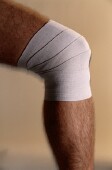ACL Reconstruction With Cadaver Tissue Risky in Younger Patients
Failure rate after surgery as high as 24% in middle-age patients, study shows.
By Amanda Gardner
HealthDay Reporter
|
E-mail this article
Subscribe to news
Printer friendly version
|

(SOURCES: Derek K. Lichota, M.D., assistant professor, surgery, Texas A&M Health Science Center College of Medicine, and sports medicine physician, Scott & White; William Levine, M.D., chief, sports medicine, NewYork-Presbyterian Hospital/Columbia, New York City; July 10, 2008, presentation, American Orthopaedic Society for Sports Medicine, annual meeting, Orlando, Fla.)
THURSDAY, July 9 (HealthDay News) -- Using replacement ligaments from cadavers for reconstruction of the anterior cruciate ligament (ACL) may have a failure rate as high as 24 percent in active patients under the age of 40.
The finding, from researchers at the Mississippi Sports Medicine and Orthopaedic Center, which were to be presented Thursday at the American Orthopaedic Society for Sports Medicine annual meeting, in Orlando, Fla., raises the question as to whether other alternatives would be better for younger ACL patients.
An estimated 800,000 ACL tears occur each year in the United States, with the number of ACL replacement surgeries correspondingly high.
Golf legend Tiger Woods may be the most recent well-known casualty. He recently announced that he would be undergoing ACL surgery this year, requiring him to sit out the rest of the 2008 season.
"The ACL is one of the ligaments in the center part of the knee that stops the shin bone from sliding forward," explained Dr. Derek K. Lichota, an assistant professor of surgery at Texas A & M Health Science Center College of Medicine and a sports medicine physician at Scott & White. "When you rupture it, the majority of patients' knees become unstable so, routinely, especially for young, active people, we recommend reconstruction."
The choices for reconstruction include a ligament from the patellar-tendon bone, the hamstring tendons or a ligament from a cadaver.
For this study, 64 patients aged 40 or older who had undergone ACL reconstruction with a replacement ligament from a cadaver were followed for at least two years.
Almost one-quarter (23.4 percent) of the reconstructions failed, meaning the patient had to undergo a second reconstruction because of additional injury, graft failure or low scores on a test of function.
The failure rate in an older group was only 2.4 percent.
While the findings may raise some red flags, a number of questions go unanswered, Lichota said.
"They don't tell us if the patients were braced postoperatively," he said, or when the second rupture occurred or the failure rates in specific subgroups of patients.
Also, the researchers did not describe the particular technique used for each replacement. "My concern is that we may be comparing apples to oranges," said Dr. William Levine, chief of sports medicine at NewYork-Presbyterian Hospital/Columbia in New York City.
More information
Visit the U.S. National Library of Medicine for more on ACL reconstruction.
Copyright © 2008 ScoutNews, LLC. All rights reserved. 
HealthDayNews articles are derived from various sources and do not reflect federal policy. healthfinder.gov does not endorse opinions, products, or services that may appear in news stories. For more information on health topics in the news, visit the healthfinder.gov health library.